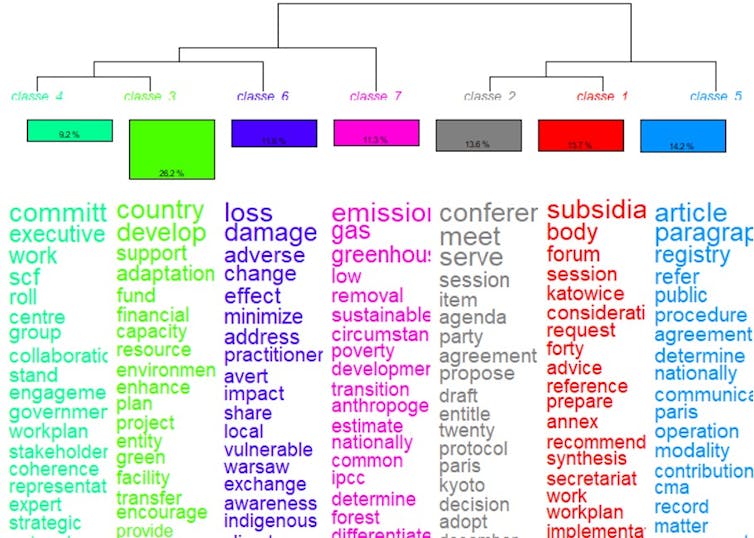Source: The Conversation – France in French (2) – By Albin Wagener, Professeur en analyse de discours et communication à l’ESSLIL, chercheur au laboratoire ETHICS, Institut catholique de Lille (ICL)
Derrière les grandes déclarations de la diplomatie climatique, que disent vraiment les textes des COP ? Une étude de leurs discours, passés au crible du « text mining », montre comment les mots des COP sont davantage centrés sur les mécaniques institutionnelles que sur l’urgence environnementale. Le langage diplomatique sur le climat fabrique ainsi un récit institutionnel dont la nature est presque absente.
Alors que la COP30 se tient au Brésil en ce mois de novembre 2025, des voix s’élèvent : ces montagnes onusiennes accoucheraient-elles de souris ? En effet, ces grand-messes du climat aboutissent le plus souvent à des textes consensuels. Certes, ils reconnaissent – sur le papier – la réalité des enjeux climatiques, mais ils ne sont que rarement suivis d’effets. On se souvient, par exemple, du texte de la COP26, à Glasgow (2021), qui évoquait enfin clairement la question de la sortie des énergies fossiles. Mais la mise en œuvre de cette promesse, non réitérée lors de la COP29, à Bakou (2024), reste encore à concrétiser.
Leur processus de décision même est de plus en plus critiqué. Il ne fait intervenir que les délégations nationales à huis clos, tout en donnant un poids important aux lobbies. On y retrouve bien sûr des ONG, mais aussi des grandes entreprises, comme Coca-Cola lors de la COP27, à Charm el-Cheikh (2022). L’occasion pour les États producteurs d’énergie fossile de se livrer à des opérations remarquables d’écoblanchiment – comme les Émirats arabes unis furent accusés de le faire lors de la COP28 à Dubaï. Dans le même temps, les populations autochtones et les mouvements des jeunes pour le climat peinent à se faire entendre à l’occasion de ces événements.
Afin de mieux comprendre l’évolution sémantique dans les déclarations des COP et de voir dans quelle mesure celles-ci reflètent l’urgence climatique, j’ai mené une analyse de discours à partir des déclarations officielles (en anglais) des COP entre 2015 – soit juste après la signature de l’accord de Paris – et 2022. Cela permet de mieux saisir les représentations sociales des instances internationales à propos du changement climatique, dans la mesure où ces discours prennent sens au cours de leur circulation dans la société.
Écolinguistique et text mining, mode d’emploi
Cette étude s’inscrit dans l’approche écolinguistique héritée des travaux d’Arran Stibbe ; une approche qui permet notamment d’explorer la manière dont les institutions cadrent les discours sur l’environnement, tout en aidant à comprendre comment les intérêts divergents d’acteurs différents aboutissent à des positions médianes. Pour le climat comme pour les autres grands sujets politiques internationaux, la façon dont les acteurs en parlent est capitale pour aboutir à des consensus, des prises de décision et des textes engageant les États.
J’ai mené cette analyse grâce à l’outil Iramuteq, développé par Pascal Marchand et Pierre Ratinaud. Il permet une approche statistique du nombre de mots présents dans un corpus textuel, des mots avec lesquels ils apparaissent le plus souvent, mais également de les croiser avec les définitions et leur sens en contexte.

Fourni par l’auteur
Par ordre de poids statistique, on retrouve ainsi les thèmes suivants :
-
Fonds de soutien international (26,2 %, en vert fluo, classe 3), qui recoupe les discussions sur l’aide aux pays en voie de développement et la proposition d’un fonds afin de faire face au changement climatique.
-
Textes des COP (14,2 %, en bleu, classe 5). Cette catégorie intègre les passages qui évoquent le fonctionnement des COP elles-mêmes et des leurs organes administratifs, dont les objectifs sont actés grâce aux textes.
-
Préparation des COP (13,7 %, en rouge, classe 1). Il s’agit de tout le jargon lié aux coulisses des COP et aux travaux d’organisation qui permettent aux COP d’aboutir et à leurs décisions d’être appliquées de manière concrète.
-
Organisation des COP (13,6 %, en gris, classe 2). Il s’agit du détail concernant les événements des COP elles-mêmes, c’est-à-dire leur organisation et leur calendrier, avec le fonctionnement par réunions et documents à produire.
-
Conséquences négatives du changement climatique (11,6 % seulement, en violet, classe 6). Il s’agit des passages où l’accent est mis sur les dommages, les risques et les vulnérabilités, c’est-à-dire les conséquences négatives du réchauffement climatique.
-
Écologie (11,3 %, rose, classe 7). Cette classe traite des éléments d’ordre écologique liés au changement climatique, ainsi que des causes du réchauffement planétaire.
-
Gouvernance de la COP (9,2 %, vert pâle, classe 4). Dans cette dernière classe, on retrouve les éléments d’ordre stratégique liés aux COP, à savoir la gouvernance, les parties prenantes, les groupes de travail et les plans à suivre.
À lire aussi :
Les mots de la COP : dictionnaire portatif des négociations climatiques
Que retenir de ce découpage ? Les questions strictement climatiques et écologiques ne totalisent que 22,9 % des occurrences dans les textes, ce qui paraît assez faible alors qu’il s’agit des raisons pour lesquelles ces COP existent. Dans une grande majorité des thématiques abordées par le corpus, les COP parlent d’abord d’elles-mêmes.
C’est peu surprenant pour une institution internationale de ce calibre, mais cela pose de sérieuses questions concernant la prise en compte des dimensions extra-institutionnelles du problème.
L’écologie déconnectée des autres mots clés
J’ai ensuite poussé le traitement des données un peu plus loin grâce à une méthode statistique appelée « analyse factorielle de correspondance ». Celle-ci permet de comprendre comment les différentes thématiques sont articulées entre elles dans les discours au sein du corpus.
Les récits en lien avec les thèmes qu’on retrouve au centre droit du graphe, liés aux textes des COP (bleu), à leur préparation (rouge), à leur organisation (gris) et à leur gouvernance (vert pâle) forment ainsi un ensemble homogène.
On note toutefois, dans la partie en bas à gauche, que la gouvernance des COP (vert pâle) a un positionnement hybride et semble jouer le rôle d’interface avec la thématique des conséquences négatives du réchauffement climatique (violet) et celle des fonds de soutien internationaux (vert fluo).
En d’autres termes, ces observations confirment que les COP se donnent bien pour objectif de remédier aux conséquences du changement climatique. Et cela, à travers la gouvernance mise en place par les COP, et avec la proposition d’aides aux pays les plus vulnérables comme moyen.
Quant au thème de l’écologie (en rose), il se retrouve en haut à gauche du graphe. Surtout, il semble comme déconnecté du reste des thématiques. Ceci montre que, dans ces textes, il existe peu de liens entre les propos qui traitent de l’écologie et ceux qui évoquent le fonctionnement des COP ou la mise en œuvre concrète de solutions.
À lire aussi :
Les classes populaires en ont-elles vraiment marre de l’écologie ?
L’absence de termes pourtant centraux
Plus intéressant encore, les textes analysés brillent par l’absence relative de certains termes clés.
Ainsi, le terme animal (en anglais) n’est jamais utilisé. Certains termes n’apparaissent qu’une fois dans tous les textes étudiés, comme life, river ou ecological. D’autres apparaissent, mais très peu, comme natural (trois occurrences), earth (quatre occurrences). Des termes comme water, biodiversity ou ocean, aux enjeux colossaux, ne totalisent que six occurrences.
Ainsi, alors que les COP ont pour objectif de s’intéresser aux conséquences du réchauffement climatique sur les sociétés humaines et le vivant en général, il est marquant de constater que la plupart des champs thématiques du corpus parlent non pas des problèmes liés au changement climatiques, mais surtout des COP elles-mêmes, plus précisément de leur fonctionnement.
En d’autres termes, les COP se parlent à elles-mêmes, dans une logique de vase clos qui vise d’abord à s’assurer que les dispositions prises pour respecter l’accord de Paris sont bien respectées.
À lire aussi :
À quoi servent les COP ? Une brève histoire de la négociation climatique
Cet état de fait contraste avec les conséquences concrètes du réchauffement climatique. Il illustre la vivacité de représentations d’ordre gestionnaire et institutionnel, qui s’autoalimentent en voyant d’abord l’environnement, la biodiversité et le vivant comme des ressources à préserver ou des objectifs à accomplir. En restant focalisées sur l’accord de Paris, les déclarations officielles voient ainsi le vivant et la biodiversité comme autant d’outils, d’objets ou de cases à cocher pour rendre compte d’engagements pris au niveau international.
C’est compréhensible étant donnée la nature des textes des COP et du contexte socio-institutionnel qui encadrent leur production. Il n’en reste pas moins que cela trahit bon nombre de représentations qui continuent de percoler nos imaginaires. Dans cette logique, les éléments d’ordre naturel, environnemental ou écologique constituent soit des ressources à utiliser ou préserver, soit des éléments à gérer, soit des objectifs à remplir. Or, cette représentation est loin d’être neutre, comme l’explique George Lakoff.
Ici, le changement climatique est donc traité comme un ensemble de problèmes auxquels il s’agit d’apporter de simples solutions techniques ou des mécanismes de compensation, sans que les conditions qui alimentent ce même dérèglement climatique (notamment liées au système économique et aux modes de production et de consommation) ne soient abordées à aucun moment dans les textes.
C’est cette même logique qui semble condamner les instances internationales à tenter de gérer les conséquences du réchauffement climatique, tout en évitant soigneusement d’en traiter les causes.
![]()
Albin Wagener ne travaille pas, ne conseille pas, ne possède pas de parts, ne reçoit pas de fonds d’une organisation qui pourrait tirer profit de cet article, et n’a déclaré aucune autre affiliation que son organisme de recherche.
– ref. Les textes des COP parlent-ils vraiment de climat ? Le regard de l’écolinguistique – https://theconversation.com/les-textes-des-cop-parlent-ils-vraiment-de-climat-le-regard-de-lecolinguistique-269674







